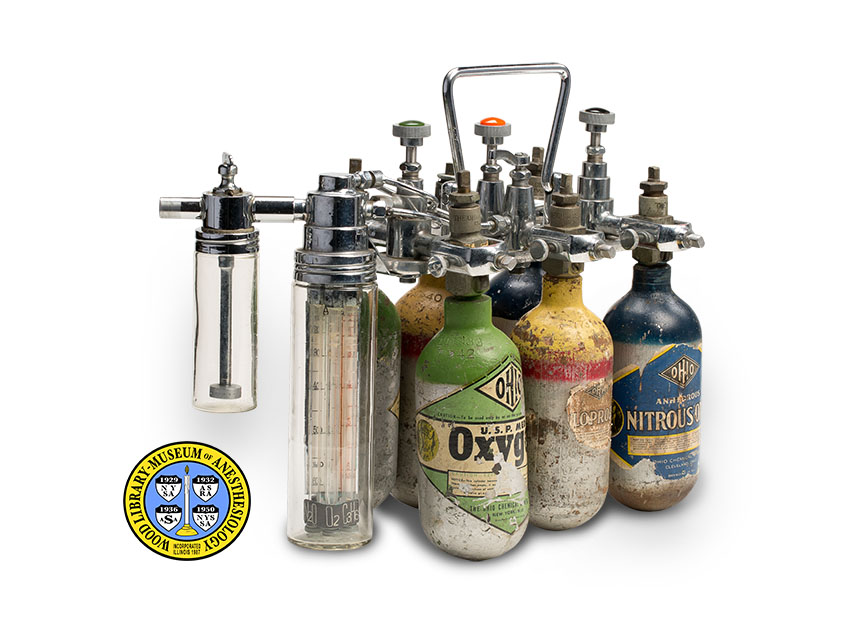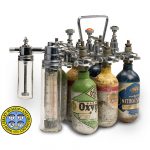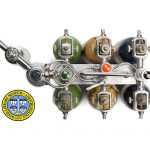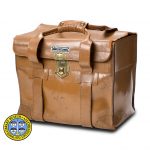Australian Model
Called the "Australian Midget," this apparatus was one of a line of ‘Foregger Midget’ anesthesia machines. The Foregger Company of Roslyn, New York used this now-antiquated word to emphasize the small size and portability of the machines. The original machine, first advertised in 1927, was designed with input from anesthesiologist Ralph Waters, MD, (1883-1979) to be used with a Waters’ Carbon Dioxide (CO2) Absorber. Rebreathing the expired anesthetic mixture, allowed by the CO2 absorber, resulted in the consumption of less gas during anesthesia. This permitted the use of small gas cylinders and resulted in a very portable design.
The variety in this line of machines was generally the result of specific design requests from individual anesthesiologists. The design of the Australian model was based on input from Dr. Gilbert Troup of Perth, Australia. During WWII, Lieutenant-Colonel Troup served as the commanding officer of the Australian General Hospital. His machine was configured with six yokes and one flowmeter each for oxygen, cyclopropane, and nitrous oxide. The nitrous oxide flowmeter originally had a second scale to allow the machine to also be used for the administration of ethylene. Variations of the Australian Model were manufactured from approximately 1937 to at least 1959.
Catalog Record: Australian Model
Access Key: almr
Accession No.: No accession number.
Title: [Australian Midget] / [C. R. Troup].
Author: Troup, Gilbert R., 1986-1962.
Corporate Author: Foregger Company.
Title variation: Alt Title
Title: Foregger Australian midget
Title variation: Alt Title
Title: Foregger Australian model.
Publisher: New York : Foregger, [between 1937 and 1949?].
Physical Descript: 1 anesthesia machine : metals, glass, rubber, plastics ; 34.5 x 23.5 x 39 cm.
Subject: Anesthesia Machines – history.
Subject: Cyclopropane.
Subject: Ethylene.
Subject: Anesthesia, Inhalation – instrumentation.
Subject: World War II.
Note Type: General
Notes: The early year in the date range for the possible year of manufacture of this
device is based on the first Foregger catalog in which an Austrailian Midget
appears (1937). The end-year is based on the year of the catalog in which the
device is only paired with a different flow-meter – the “Outside Flowmeter”
(1949). The device described here is not an exact match to the device as
illustrated in the 1937 and 1942 (nor later catalogs) but it very closely
matches the features and functions of the Austrailian Midger. The date range
could change if documentation indicates that it should be corrected.
Note Type: General
Notes: The title and name of designer were taken from the 1937 Foregger catalog,
“Catalog No. 7,” exactly as they appear on page 22. There is an error in the
designer’s name in all of the catalogs – “C.” could be “G”. This is the first
Foregger catalog in which this apparatus appears.
Note Type: Citation
Notes: Ball CM. The Foregger Midget: a machine that traveled. Anesthesiology.
2013;119(5):1023-1030. https://anesthesiology.pubs.asahq.org/article.
aspx?articleid=1918087. Accessed March 1, 2015.
Note Type: Citation
Notes: Catalog No. 7. Roslyn, New York: The Foregger Company, Inc.; 1937:22.
Note Type: Citation
Notes: Catalog No. 8. New York: The Foregger Company, Inc.; 1942:9-11, 34-35. [These
pages contain a written description of the difference between a Foregger
“Inside Flowmeter” and an “Outside Flowmeter”.]
Note Type: Citation
Notes: Catalog No. 9. New York: The Foregger Company, Inc.; 1949:9-10, 27.
Note Type: Physical Description
Notes: One portable anesthesia machine; The measurements and description are based
on treating the end of the machine with the married ether vaporizer and
flowmeters as the front of the device; The measurements in the physical
description field, 34.5 x 23.5 x 39 cm, were taken with the vaporizer and
tanks on the machine; The unit without the vaporizer and tanks measures
approximately 33.5 x 23 x 33 cm; The ether vaporizer was married to the item
for completeness of the photograph taken for the website; The accession
number for the vaporizer is 2014-09-18-2; The water depression flowmeter, or
“Inside Flowmeter,” measures approximately 26.5 x 6 x 8 cm; There are three
flowmeters, from left to right marked, N2O, O2 and C3H6; The Austrailian
Midget is supposed to have four scales (an ethylene scale to the left of the
N2O flowmeter, and a N2O scale to the right of the N2O flowmeter), but this
example has three scales, one for N2O, one for O2, and one for C3H6; Three
rows of yokes extend back from the flowmeter; The first row is for oxygen and
marked on each yoke is O2; Between the two yokes on the ‘spine’ of the
machines is a green turn knob stamped with O2; The yoke on the second row of
yokes is marked with C3H6, and has it’s own orange turn knob stamped with
C3H6; The yoke in the second row on the right is not marked and has a
turn-lever rather than a knob; The yokes in the third row are both marked N2O
and a black turn knobbed stamped with N2O) is located on the ‘spine’ of the
machine between the two yokes; All but the ‘unmarked’ yoke are also marked
with the following, “US PATENT [new line] October 24th 1922”; A carrying
handle folds out of the way of the knobs, to the left, for when the machine
is in use; The underside of the ‘spine’ is marked with “11582”.
Note Type: Reproduction
Notes: Photographed by Mr. Steve Donisch November 12, 2014. Photographed with a
Foregger leather carrying case for Foregger Midget machines (alms), and
married to a Foregger ether vaporizer (accession number 2014-09-18–2).
Note Type: Historical
Notes: Called the “Australian Midget,” this apparatus was one of a line of ‘Foregger
Midget’ anesthesia machines. The Foregger Company of Roslyn, New York used
this now-antiquated word to emphasize the small size and portability of the
machines. The original machine, first advertised in 1927, was designed with
input from anesthesiologist Ralph Waters, MD, (1883-1979) to be used with a
Waters’ carbon dioxide (CO2) absorber. Rebreathing the expired anesthetic
mixture, allowed by the CO2 absorber, resulted in the consumption of less gas
during anesthesia. This permitted the use of small gas cylinders and resulted
in a very portable design.
The variety in this line of machines was generally the result of specific
design requests from individual anesthesiologists. The design of the
Australian model was based on input from Dr. Gilbert Troup of Perth,
Australia. During WWII, Lieutenant-Colonel Troup served as the commanding
officer of the Australian General Hospital. His machine was configured with
six yokes and one flowmeter each for oxygen, cyclopropane, and nitrous oxide.
The nitrous oxide flowmeter originally had a second scale to allow the
machine to also be used for the administration of ethylene. Variations of the
Australian Midget were manufactured from approximately 1937 to at least 1959.
Other machines in this line of portable devices included the “Muir Midget,”
which was first described in the 1935 Foregger catalog. It was designed by Dr
R.M. Muir of Capetown South Africa. The “Fox Hole Midget” was designed with
input from U.S. Naval Reserve Commander Albert J. Wineland, MD, who served in
the South Pacific during World War II. His machine first appeared in the 1949
Foregger catalog.
Note Type: Exhibition
Notes: Exhibited at the National World War II Museum in New Orleans, October, 2014;
Selected for the WLM website.




